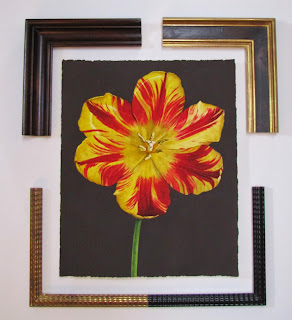I wanted to take a few moments to talk about framing and it's different historical styles. Frame styles are generally categorized by their country of origin. The more popular being the Dutch, Italian, American and French and the Modern.
If I'm framing a period work of art, I'll try to match the country of the artist or subject to the frame style also from that country. One of my favorite things to do here in DC is to take a walk down to the National Gallery and study how the art is placed with the framing. The National Gallery is unique to museums both here in the States and in other countries I've visited since the permanent collection is separated in different rooms by country of origin. You get a more complete view of that countries' work this way.
If I had to pick my favorite style of framing, I'd have to say it is the Dutch. The Dutch framing is generally associated with dark woods and carvings of waves and basket weaving as in the example below.
What better style of frame to place with my tulips than the Dutch. Below are four examples from this category. The top two show the classic ripples, one in a dark ebony finish and the other in an antiqued 23k gold. The bottom two show a typical Dutch reverse flat panel painted in an antique green with 23k gold ripples with the second in an antiqued 12k white gold.
Of course other styles of frames work beautifully with the tulips as well.
The top left shows an American Mahogany stain while the other shows an Italian flat panel of Burl with 23k gold. The bottom shows the same Dutch ripples. The effect is very different when they are placed with the tulip painted on the dark chocolate ground.
Another popular frame style is from the French. This category is generally divided by the Louis. Louis 13th, 14th, 15th, and 16th. A period example shows a typical Louis 13th.
The grouping below shows examples from this category.
The top left shows a Louis 14th which tends to have flatter carvings to simulate brocade than the Louis 13th on the right which tends to be more elaborate. The bottom left shows a Louis 16th in an ebony finish whereas the right shows a Louis 16th in an ebony finish with 23k gold carving on the inside of the profile.
The next photo shows various examples with a more modern flair.
The top left is a Modern style of matte 23k gold. Although the top right is technically from the American category, the ivory and black finish gives it a contemporary feel. The bottom left is an Art Deco step in 23k gold with the bottom right being the cleanest Modern style with the ivory cap.
The next shot shows the last tulip in full color with similar frames as above but with a slim 12k. white gold on the left and a 23k cap on the right.
The tulip below was painted in white on a ground of Farrow and Ball, Powder Blue.
The top left is an Italian in antiqued 12k white gold whereas the right shows the same gold but in a clean water gild finish. The bottom left is a Dutch antiqued 12k white gold with the right being the Modern ivory cap. How beautiful would a set of these be in a bedroom?
The next, more stark image shows the same profiles as above but with a tulip painted in white on Farrow and Ball, Mahogany.
Finally, I wanted to have a little fun. Although I generally stay away from color mats, how modern and fresh would a collection of these be?
I hope I was able to give you a better understanding of why I'm so passionate about framing and all of the possibilities that can be achieved.





























































